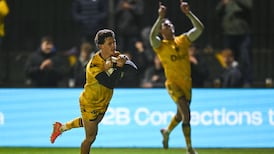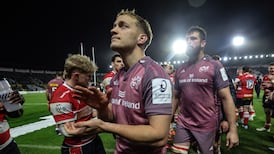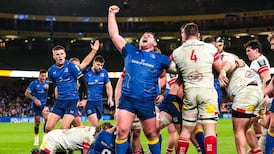It’s there in black and white. “In both the tackle and cleanout a player must not make contact with an opponent above the line of the shoulders.” The censure for those that transgress is a yellow or red card. That’s an edict from World Rugby following a meeting last month, the upshot of which was for them to declare that “certain aspects of foul play law needed to be reinforced by match officials”.
It's worth bearing in mind those words in sifting through the post-match kerfuffle following Munster's 36-22 Heineken Champions Cup victory over Gloucester at Thomond Park. The shorthand version of events is that Gloucester outhalf Danny Cipriani received a red card, Tom Savage (Gloucester), Sam Arnold (Munster) and Stephen Archer (Munster) yellow cards and Billy Twelvetrees (Gloucester) escaped any punishment.
Gloucester supporters were seething with French referee Alexandre Ruiz and his officials. The English club's head coach Johan Ackermann chose tiptoe diplomacy but was clearly unhappy with the sending off while his Munster counterpart Johann van Graan correctly identified a glut of head-high shots but acknowledged that there was no malice in two of the more high-profile incidents.
Ackermann said: “My view is simple; it’s spoiling the game if there’s no intent. I’ve got a lot to say, but I’m not going to say it. It’s not going to change anything.
“[Danny] is disappointed. If they come and watch how he trains, that’s how he protects himself. It’s a normal habit, he didn’t even want to tackle the guy; he wanted to get out of it. It’s done and dusted, if the supporters come and pay to watch 14 v 15; that’s a great way for rugby [to go] forward.”
Clumsy
Ascribing intent on the part of the tackler is irrelevant – clumsy tackles still break bones – while an outcome-driven punishment scale, the extent of the damage inflicted in the incident, should not have any bearing on the decision taken by the referee. Those considerations would be more relevant to a citing process and disciplinary hearing.
World Rugby is intent on taking a hard line when it comes to high tackles just as they did several years ago in relation to tip tackles and also players being taken out in the air. There has been an appreciable decline in both offences since then. Were some players unlucky to be sent off? Yes, absolutely. Will it be the same in relation to adjudicating on high tackles? Yes, undoubtedly.
The collateral damage of lob-sided matches, personnel wise, will be frustrating and disappointing in the short term but if it recalibrates tackle heights and significantly reduces head shots and neck rolls then there isn’t an argument.
The key to making what is bitter medicine more palatable for players and coaches alike is consistency of interpretation from the officials and that is a legitimate criticism arising from the weekend. There could have been three red cards in the game. The “accidents happen” philosophy won’t get much traction as a defence.
Munster captain Peter O’Mahony was unequivocal in his view of the high tackle issue, offering a player’s perspective. “It is not something that a player has to worry about. We trust the officials and their adjudication; trust them 100 per cent. It’s not something that we can worry about.
“The high tackle has been penalised forever in the game. It has never been allowed. It’s not like guys are starting to do it now. There are guys with good footwork out there who put you off balance and nine times out of 10 it is a genuine accident.
“As Johann said by the latter of the law if you are upright and high then you are in trouble. It is in the spotlight for rule changes at the moment. No one has ever practised high tackling. A lot of the time there is no intent but that is just the law.”
High shots
Van Graan was right in his assertion that there were “quite a few high shots”. He continued: “World Rugby informs us of the way that the game is going, player welfare is important and we have to adapt to that. There was certainly no intent from Stephen Archer on our side and no intent from Danny [Cipriani] on their side as well. Unfortunately a red card makes the game a bit difficult. We have to adapt to the letter of the law.”
It is perhaps germane to leave the final word on the issue of high tackles to World Rugby because ultimately they will frame how they are adjudicated upon on and off the pitch. In summation under the heading “High Tackles and Neck Contact (Law 9.13 & 9.20)”, is the statement that “match officials should work together to ensure that foul play is strictly penalised and that player welfare is paramount”.
At the very kernel of this debate in the welfare of players at all levels, of all ages, and if that’s to be more than mere lip service then the lumps and bumps in terms of cards that come with re-education in and lowering of, tackle heights, is a price worth paying.











